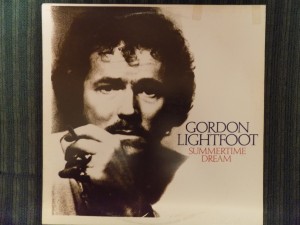The Edmund Fitzgerald, Ogdensburg, and Gordon Lightfoot

The Edmund Fitzgerald, 1971. Photo: Greenmars, Creative Commons, some rights reserved
It’s November 10. Outside my window, the sky is gray. It’s windy, and that all seems very appropriate because it’s the 41st anniversary of the most notable shipwreck of the 20th century on the Great Lakes. In 1975, the iron ore carrier SS Edmund Fitzgerald sank in a hurricane-force storm in eastern Lake Superior. All 29 aboard perished. In November 1976, legendary Canadian singer-songwriter Gordon Lightfoot embedded the tragedy in the North American conscience with his six minute and 27 second ballad The Wreck of the Edmund Fitzgerald. Lightfoot was inspired to write the song after reading about the shipwreck in Newsweek. The song made it to #3 on the American charts and it hit #1 in Canada. 40 years later, the song is still on the regular playlist of many radio stations. I first learned it in 7th grade music class. It tapped into my love of Canadian history, the Great Lakes, and made me a Gordon Lightfoot fan.

The Wreck of the Edmund Fitzgerald is on the first side of Gordon Lightfoot’s 1976 album “Summertime Dream.” Holding a cigarette for an album cover photo was perfectly acceptable 40 years ago. Photo: James Morgan
In eastern Ontario and the North Country, we know about shipping because of the Seaway, but there’s also another local connection to the Edmund Fitzgerald story. The ship’s captain, Ernest McSorley, was born in Canada but he spent most of his youth in Ogdensburg. There are more links at other places on the Great Lakes. “The Maritime Sailors Cathedral” Gordon Lightfoot sings about is the Mariner’s Church in Detroit, located on the city’s waterfront. The church bell rang 29 times for each crew member on the day after the ship went down. The actual ship’s bell was retrieved from the wreck on the Fourth of July, 1995 and is now on display at the Great Lakes Shipwreck Museum on Whitefish Point, Michigan, not far from where the tragedy occurred. One of the anchors is at another museum in Detroit. Other parks and visitor centers around Lake Superior also commemorate the Edmund Fitzgerald. In 2015, the Royal Canadian Mint issued a collector coin. The iconic Split Rock Lighthouse stands atop a vertical cliff by Lake Superior north of Duluth, Minnesota. The US Coast Guard retired it from service in 1969, but it emits a beam of light every November 10 in honor of the crew of “Big Fitz.”
The Wreck of the Edmund Fitzgerald is more than a ballad about a shipwreck. It’s a tour of the Great Lakes. Lightfoot sings of Superior and “the rooms of her ice water mansion.” Nearby, “Lake Michigan steams like a young man’s dreams, it’s islands and bays are for sportsmen.” Heading downstream, “farther below Lake Ontario, takes in what Lake Erie can send her” gives reference to how the water from four of the Great Lakes roars over Niagara Falls. It’s the sort of song whose lyrics come to mind on stormy mid-autumn days when “The gales of November come early,” or on summer days by a beach or along a highway during a Great Lakes road trip. Lightfoot captures times, places, and moods very well.
(Gordon Lightfoot is performing at the National Arts Centre in Ottawa on November 19).
Tags: canada, Gordon Lightfoot, Great Lakes, music, Ogdensburg, USA








Great song and great ship. One of the few songs that brings mist to my eyes.
Can’t say for certain I ever saw the Fitz but chances are good because I often watched the big freighters go up and down the Detroit River when growing up there. My grandmother’s house was less than a mile from the river and I often heard them tooting their horns at night when I slept at my grandmother’s.
The Fitz was the only ship lost during that storm but in 1913 between the dates of Nov. 7 and 10, 19 ships went down and 250 men lost their lives during what is called the Big Blow with winds gust to 90 mph and waves in excess of 35 feet.
I am positive Lightfoot was aware of that event when he wrote the song.
I will always be grateful that Gordon Lightfoot immortalized the Fitz and her crew in this haunting ballad, which contains some great imagery (“Superior sings/in the rooms of her ice-water mansion”). But for the record he was quite casual with the facts. The ship had loaded at an ore dock, not “some mill”, in Wisconsin, and was bound for Zug Island, near Detroit, with her cargo. And to say “the captain wired in . . .” ignores that ship-to-shore radio communication is and must be) wireless. Finally, we understand and accept that a statement made “the old cook” (“Fellas, it’s too rough to feed ya”) falls under poetic license.
I absolutely agree that Lightfoot’s reference to “the witch of November” reflects his knowledge of other calamities that occurred on Lake Superior in that month.
I will continue to listen to “The Wreck of the Edmund Fitzgerald” from time to time, and allow myself to be spellbound by Lightfoot’s sepulchral music and lyrics.
Old Gord’s 78 this year; and with the passing of Leonard Cohen last week … (sigh) tempus fugit !
Great story to honour the 41st anniversary of the sinking of the Edmund Fitzgerald.
Here in Kingston, Ontario I listen to NCPR daily, and am always impressed with the local, as well as the national NPR news and feature programs.
[…] Edmund Fitzgerald, Ogdensburg, and Gordon Lightfoot […]